Regional Gardens: Hybrid Cloud Implementation and Security Analysis
VerifiedAdded on 2023/06/11
|10
|2091
|406
Report
AI Summary
This report provides a comprehensive analysis of hybrid cloud implementation for Regional Gardens, focusing on the adoption of Platform as a Service (PaaS) and evaluating its benefits and associated issues. It identifies and addresses the security risks inherent in hybrid cloud environments, proposing necessary information security steps and a detailed business continuity plan to mitigate potential disruptions. The report also outlines the requirements for remote server administration and the strategic steps involved in migrating Regional Gardens' email instance to Amazon Web Services (AWS), highlighting critical points and potential issues within each migration phase. Ultimately, the report concludes that with proper security measures, transitioning to a cloud environment is a justifiable and beneficial strategy for Regional Gardens.
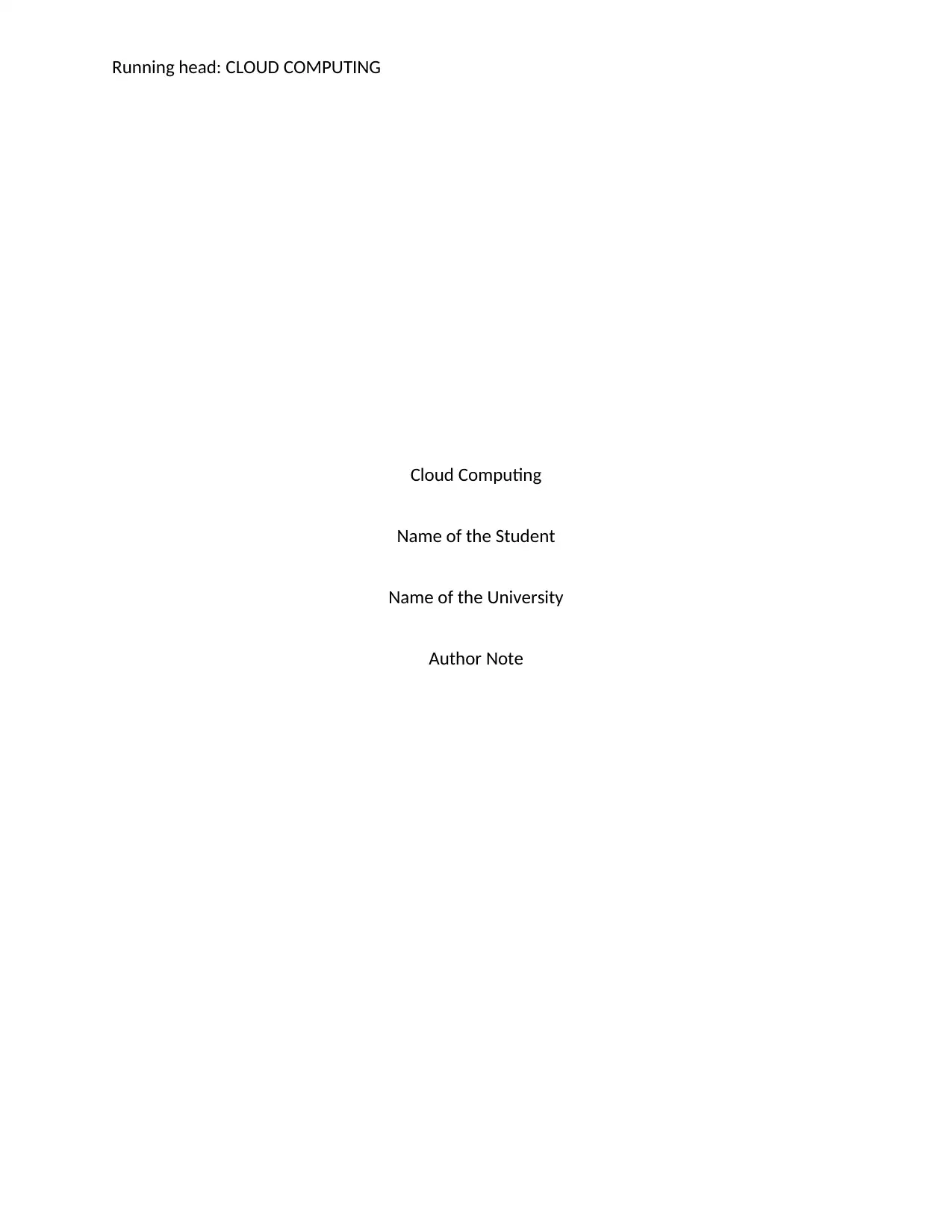
Running head: CLOUD COMPUTING
Cloud Computing
Name of the Student
Name of the University
Author Note
Cloud Computing
Name of the Student
Name of the University
Author Note
Paraphrase This Document
Need a fresh take? Get an instant paraphrase of this document with our AI Paraphraser
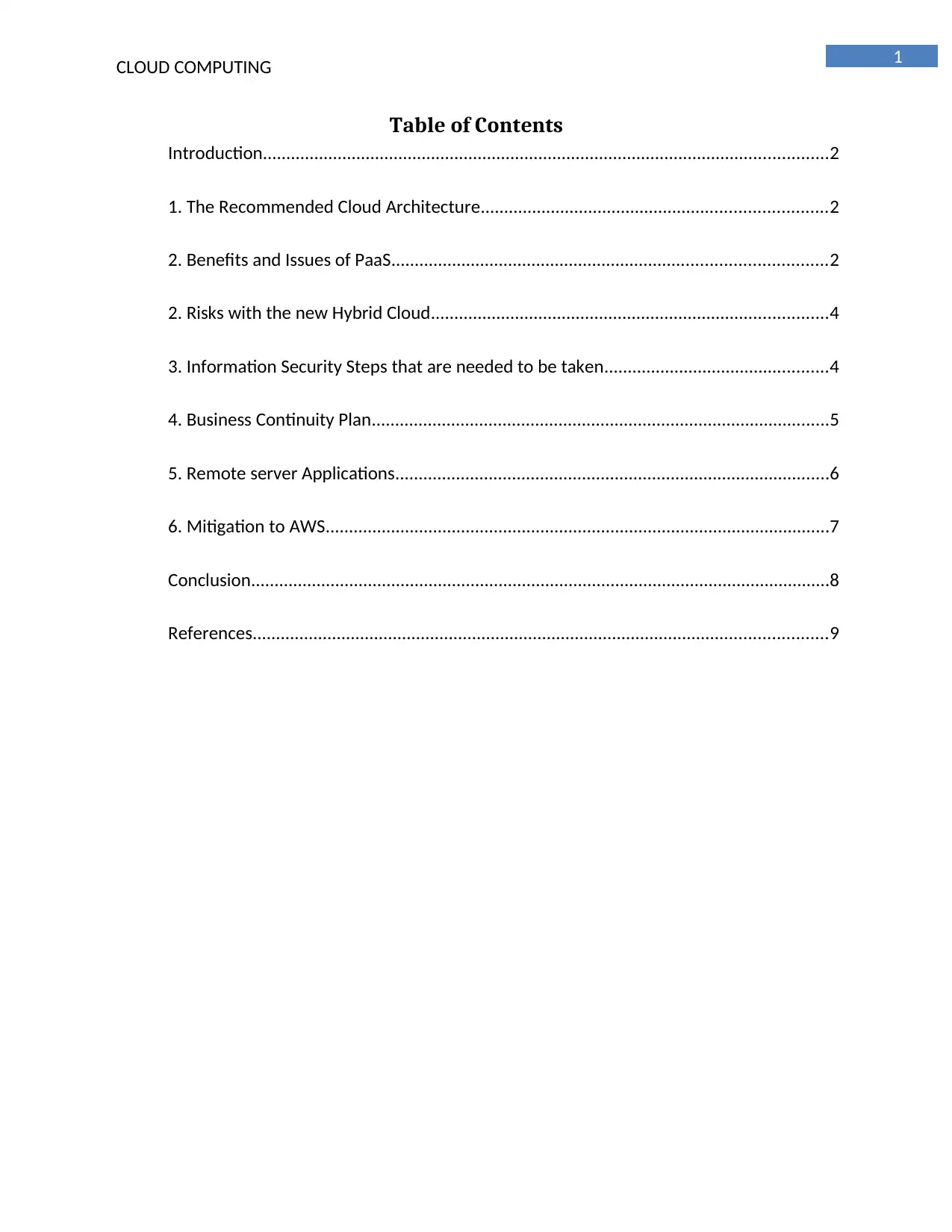
1
CLOUD COMPUTING
Table of Contents
Introduction.........................................................................................................................2
1. The Recommended Cloud Architecture..........................................................................2
2. Benefits and Issues of PaaS.............................................................................................2
2. Risks with the new Hybrid Cloud.....................................................................................4
3. Information Security Steps that are needed to be taken................................................4
4. Business Continuity Plan..................................................................................................5
5. Remote server Applications.............................................................................................6
6. Mitigation to AWS............................................................................................................7
Conclusion............................................................................................................................8
References...........................................................................................................................9
CLOUD COMPUTING
Table of Contents
Introduction.........................................................................................................................2
1. The Recommended Cloud Architecture..........................................................................2
2. Benefits and Issues of PaaS.............................................................................................2
2. Risks with the new Hybrid Cloud.....................................................................................4
3. Information Security Steps that are needed to be taken................................................4
4. Business Continuity Plan..................................................................................................5
5. Remote server Applications.............................................................................................6
6. Mitigation to AWS............................................................................................................7
Conclusion............................................................................................................................8
References...........................................................................................................................9

2
CLOUD COMPUTING
Introduction
Regional Gardens runs a number of gardening enterprises and it is also open for public
inspection. The management of the organization has decided to move to a hybrid cloud
environment in order to integrate the business operations of the organization. The report gives
an idea of the process of implementation of cloud within Regional Gardens. The risks and the
security issues associated with the use of hybrid cloud are evaluated and a business continuity
plan is proposed as well. The requirements that the Regional Gardens is needed to consider to
conduct the remote server administration is further discussed in the report.
1. The Recommended Cloud Architecture
The choice of the cloud architecture should be made on basis of the three most widely
used cloud models, which are Infrastructure as a Service, Platform as a Service and Software as
a Service. An organization can make use of these cloud architectures in accordance to the need
of the customers. A cloud model is to be recommended for Regional Gardens that will assist
Regional Gardens in meeting the Board’s Strategy. The hybrid cloud model that will be suitable
for Regional Gardens Ltd in hybrid cloud environment is Platform as a Service or PaaS. PaaS is
recommended for Regional gardens as it will help in making use of their already existing
infrastructure.
2. Benefits and Issues of PaaS
CLOUD COMPUTING
Introduction
Regional Gardens runs a number of gardening enterprises and it is also open for public
inspection. The management of the organization has decided to move to a hybrid cloud
environment in order to integrate the business operations of the organization. The report gives
an idea of the process of implementation of cloud within Regional Gardens. The risks and the
security issues associated with the use of hybrid cloud are evaluated and a business continuity
plan is proposed as well. The requirements that the Regional Gardens is needed to consider to
conduct the remote server administration is further discussed in the report.
1. The Recommended Cloud Architecture
The choice of the cloud architecture should be made on basis of the three most widely
used cloud models, which are Infrastructure as a Service, Platform as a Service and Software as
a Service. An organization can make use of these cloud architectures in accordance to the need
of the customers. A cloud model is to be recommended for Regional Gardens that will assist
Regional Gardens in meeting the Board’s Strategy. The hybrid cloud model that will be suitable
for Regional Gardens Ltd in hybrid cloud environment is Platform as a Service or PaaS. PaaS is
recommended for Regional gardens as it will help in making use of their already existing
infrastructure.
2. Benefits and Issues of PaaS
⊘ This is a preview!⊘
Do you want full access?
Subscribe today to unlock all pages.

Trusted by 1+ million students worldwide
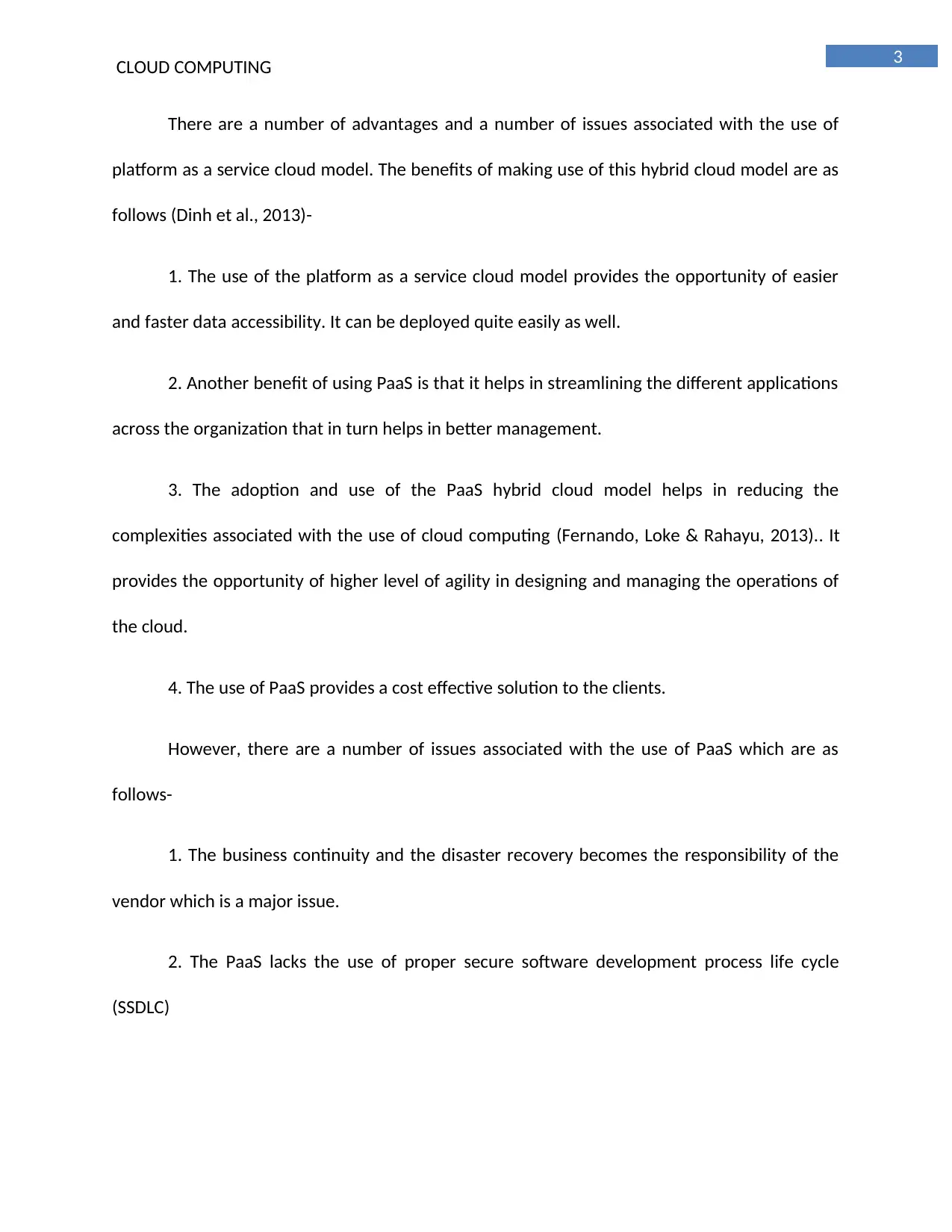
3
CLOUD COMPUTING
There are a number of advantages and a number of issues associated with the use of
platform as a service cloud model. The benefits of making use of this hybrid cloud model are as
follows (Dinh et al., 2013)-
1. The use of the platform as a service cloud model provides the opportunity of easier
and faster data accessibility. It can be deployed quite easily as well.
2. Another benefit of using PaaS is that it helps in streamlining the different applications
across the organization that in turn helps in better management.
3. The adoption and use of the PaaS hybrid cloud model helps in reducing the
complexities associated with the use of cloud computing (Fernando, Loke & Rahayu, 2013).. It
provides the opportunity of higher level of agility in designing and managing the operations of
the cloud.
4. The use of PaaS provides a cost effective solution to the clients.
However, there are a number of issues associated with the use of PaaS which are as
follows-
1. The business continuity and the disaster recovery becomes the responsibility of the
vendor which is a major issue.
2. The PaaS lacks the use of proper secure software development process life cycle
(SSDLC)
CLOUD COMPUTING
There are a number of advantages and a number of issues associated with the use of
platform as a service cloud model. The benefits of making use of this hybrid cloud model are as
follows (Dinh et al., 2013)-
1. The use of the platform as a service cloud model provides the opportunity of easier
and faster data accessibility. It can be deployed quite easily as well.
2. Another benefit of using PaaS is that it helps in streamlining the different applications
across the organization that in turn helps in better management.
3. The adoption and use of the PaaS hybrid cloud model helps in reducing the
complexities associated with the use of cloud computing (Fernando, Loke & Rahayu, 2013).. It
provides the opportunity of higher level of agility in designing and managing the operations of
the cloud.
4. The use of PaaS provides a cost effective solution to the clients.
However, there are a number of issues associated with the use of PaaS which are as
follows-
1. The business continuity and the disaster recovery becomes the responsibility of the
vendor which is a major issue.
2. The PaaS lacks the use of proper secure software development process life cycle
(SSDLC)
Paraphrase This Document
Need a fresh take? Get an instant paraphrase of this document with our AI Paraphraser
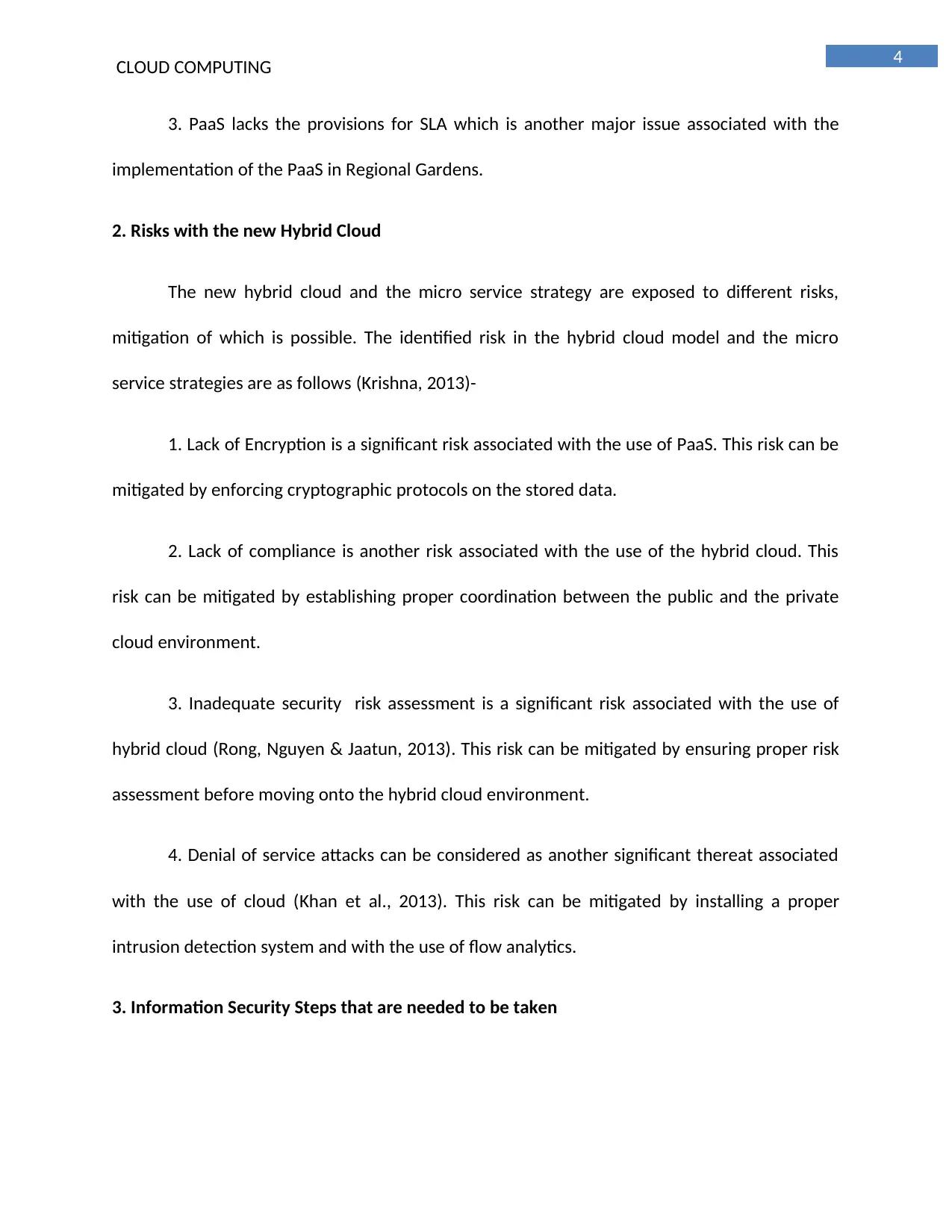
4
CLOUD COMPUTING
3. PaaS lacks the provisions for SLA which is another major issue associated with the
implementation of the PaaS in Regional Gardens.
2. Risks with the new Hybrid Cloud
The new hybrid cloud and the micro service strategy are exposed to different risks,
mitigation of which is possible. The identified risk in the hybrid cloud model and the micro
service strategies are as follows (Krishna, 2013)-
1. Lack of Encryption is a significant risk associated with the use of PaaS. This risk can be
mitigated by enforcing cryptographic protocols on the stored data.
2. Lack of compliance is another risk associated with the use of the hybrid cloud. This
risk can be mitigated by establishing proper coordination between the public and the private
cloud environment.
3. Inadequate security risk assessment is a significant risk associated with the use of
hybrid cloud (Rong, Nguyen & Jaatun, 2013). This risk can be mitigated by ensuring proper risk
assessment before moving onto the hybrid cloud environment.
4. Denial of service attacks can be considered as another significant thereat associated
with the use of cloud (Khan et al., 2013). This risk can be mitigated by installing a proper
intrusion detection system and with the use of flow analytics.
3. Information Security Steps that are needed to be taken
CLOUD COMPUTING
3. PaaS lacks the provisions for SLA which is another major issue associated with the
implementation of the PaaS in Regional Gardens.
2. Risks with the new Hybrid Cloud
The new hybrid cloud and the micro service strategy are exposed to different risks,
mitigation of which is possible. The identified risk in the hybrid cloud model and the micro
service strategies are as follows (Krishna, 2013)-
1. Lack of Encryption is a significant risk associated with the use of PaaS. This risk can be
mitigated by enforcing cryptographic protocols on the stored data.
2. Lack of compliance is another risk associated with the use of the hybrid cloud. This
risk can be mitigated by establishing proper coordination between the public and the private
cloud environment.
3. Inadequate security risk assessment is a significant risk associated with the use of
hybrid cloud (Rong, Nguyen & Jaatun, 2013). This risk can be mitigated by ensuring proper risk
assessment before moving onto the hybrid cloud environment.
4. Denial of service attacks can be considered as another significant thereat associated
with the use of cloud (Khan et al., 2013). This risk can be mitigated by installing a proper
intrusion detection system and with the use of flow analytics.
3. Information Security Steps that are needed to be taken

5
CLOUD COMPUTING
Proper information security is needed to be analysed in order to prevent the
unauthorized data access and disclosure of the confidential information that is stored in the
hybrid cloud database. The information security steps that will be taken are as follows-
1. The security from the advanced threats will be ensured. For this, the listing of the
advanced security threats is quite essential.
2. The security scaling is needed to be ensured as an essential security step to be taken.
3. Another information security step that is needed to be ensured is getting an
optimized security. This will ensure that the basic mitigation strategies for the identified risks
are in action.
4. Business Continuity Plan
Business continuity plan (BCP) is needed to be developed so that the business is not
largely affected even during the disasters. A business continuity plan helps in ensuring that the
risks associated with the business are properly accessed. The process or steps by which regional
gardens will design and implement their business continuity plan is discussed below-
1. Regional gardens BCP should incorporate the analysis of the business impact to
understand the severity of the risks associated with the system and the business processes
running within the organization (Pearson, 2013).
2. After proper recommendation, it is essential to document the risks recognized and
the security measures that can be used to address the risks.
CLOUD COMPUTING
Proper information security is needed to be analysed in order to prevent the
unauthorized data access and disclosure of the confidential information that is stored in the
hybrid cloud database. The information security steps that will be taken are as follows-
1. The security from the advanced threats will be ensured. For this, the listing of the
advanced security threats is quite essential.
2. The security scaling is needed to be ensured as an essential security step to be taken.
3. Another information security step that is needed to be ensured is getting an
optimized security. This will ensure that the basic mitigation strategies for the identified risks
are in action.
4. Business Continuity Plan
Business continuity plan (BCP) is needed to be developed so that the business is not
largely affected even during the disasters. A business continuity plan helps in ensuring that the
risks associated with the business are properly accessed. The process or steps by which regional
gardens will design and implement their business continuity plan is discussed below-
1. Regional gardens BCP should incorporate the analysis of the business impact to
understand the severity of the risks associated with the system and the business processes
running within the organization (Pearson, 2013).
2. After proper recommendation, it is essential to document the risks recognized and
the security measures that can be used to address the risks.
⊘ This is a preview!⊘
Do you want full access?
Subscribe today to unlock all pages.

Trusted by 1+ million students worldwide

6
CLOUD COMPUTING
3. Proper compliance of the BCP is necessary in order to comply with the proper
management of a business disruption.
4. Finally, it is essential to provide a proper training to the employees for infusing a
proper understanding of the strategies of the business continuity plan.
However, there are certain issues associate with the back up and disaster recovery in a
hybrid cloud environment, which are as follows-
1. slow cloud adoption is a significant issues associated with the use of hybrid cloud
environment.
2. Slow data recovery is another issues associated with the BCP of hybrid cloud.
3. The backups and disaster recovery strategies that are used in cloud computing are
less reliable.
The above discussed points give an idea of the major issues associated with application
resilience, back up and disaster recovery in hybrid cloud environment.
5. Remote server Applications
There are a number of requirements which are needed to be acknowledged for
establishing a proper remote server administration in Regional Gardens. The significant tools of
service administration include server manager, consoles, Microsoft management Console and
so on. Shared resources are the most important requirement associated with the resource
management (Li et al., 2013). The shared resources are extremely important in both IaaS and
CLOUD COMPUTING
3. Proper compliance of the BCP is necessary in order to comply with the proper
management of a business disruption.
4. Finally, it is essential to provide a proper training to the employees for infusing a
proper understanding of the strategies of the business continuity plan.
However, there are certain issues associate with the back up and disaster recovery in a
hybrid cloud environment, which are as follows-
1. slow cloud adoption is a significant issues associated with the use of hybrid cloud
environment.
2. Slow data recovery is another issues associated with the BCP of hybrid cloud.
3. The backups and disaster recovery strategies that are used in cloud computing are
less reliable.
The above discussed points give an idea of the major issues associated with application
resilience, back up and disaster recovery in hybrid cloud environment.
5. Remote server Applications
There are a number of requirements which are needed to be acknowledged for
establishing a proper remote server administration in Regional Gardens. The significant tools of
service administration include server manager, consoles, Microsoft management Console and
so on. Shared resources are the most important requirement associated with the resource
management (Li et al., 2013). The shared resources are extremely important in both IaaS and
Paraphrase This Document
Need a fresh take? Get an instant paraphrase of this document with our AI Paraphraser
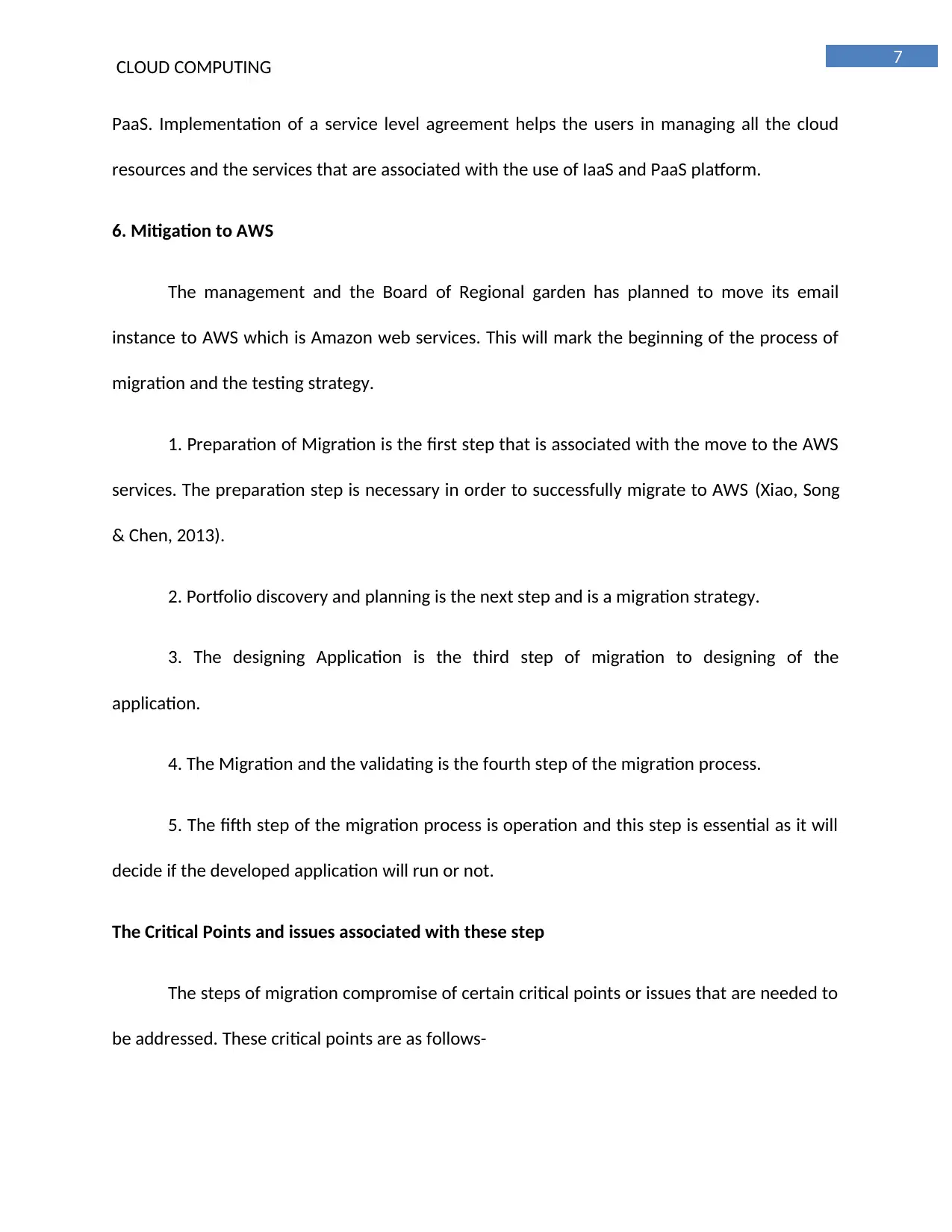
7
CLOUD COMPUTING
PaaS. Implementation of a service level agreement helps the users in managing all the cloud
resources and the services that are associated with the use of IaaS and PaaS platform.
6. Mitigation to AWS
The management and the Board of Regional garden has planned to move its email
instance to AWS which is Amazon web services. This will mark the beginning of the process of
migration and the testing strategy.
1. Preparation of Migration is the first step that is associated with the move to the AWS
services. The preparation step is necessary in order to successfully migrate to AWS (Xiao, Song
& Chen, 2013).
2. Portfolio discovery and planning is the next step and is a migration strategy.
3. The designing Application is the third step of migration to designing of the
application.
4. The Migration and the validating is the fourth step of the migration process.
5. The fifth step of the migration process is operation and this step is essential as it will
decide if the developed application will run or not.
The Critical Points and issues associated with these step
The steps of migration compromise of certain critical points or issues that are needed to
be addressed. These critical points are as follows-
CLOUD COMPUTING
PaaS. Implementation of a service level agreement helps the users in managing all the cloud
resources and the services that are associated with the use of IaaS and PaaS platform.
6. Mitigation to AWS
The management and the Board of Regional garden has planned to move its email
instance to AWS which is Amazon web services. This will mark the beginning of the process of
migration and the testing strategy.
1. Preparation of Migration is the first step that is associated with the move to the AWS
services. The preparation step is necessary in order to successfully migrate to AWS (Xiao, Song
& Chen, 2013).
2. Portfolio discovery and planning is the next step and is a migration strategy.
3. The designing Application is the third step of migration to designing of the
application.
4. The Migration and the validating is the fourth step of the migration process.
5. The fifth step of the migration process is operation and this step is essential as it will
decide if the developed application will run or not.
The Critical Points and issues associated with these step
The steps of migration compromise of certain critical points or issues that are needed to
be addressed. These critical points are as follows-
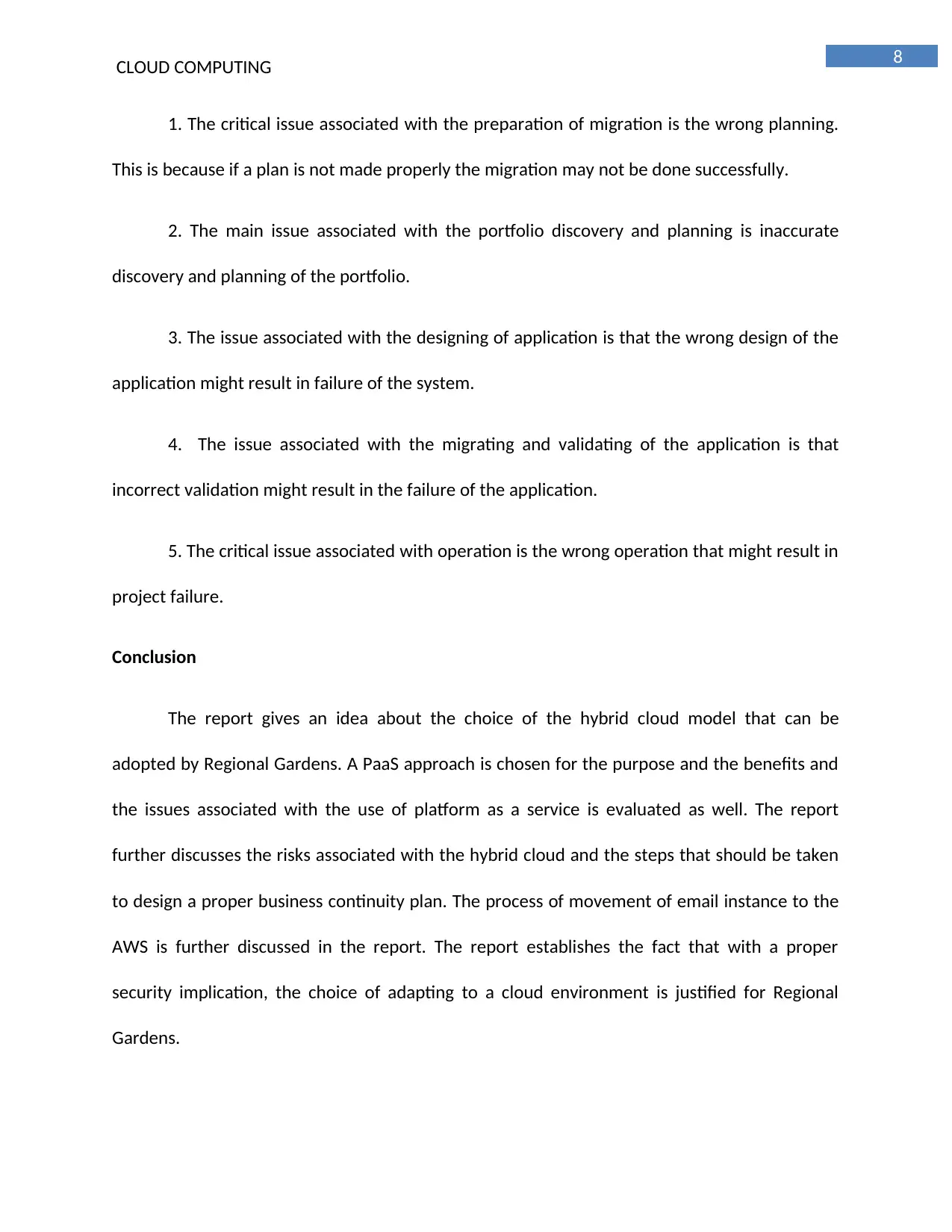
8
CLOUD COMPUTING
1. The critical issue associated with the preparation of migration is the wrong planning.
This is because if a plan is not made properly the migration may not be done successfully.
2. The main issue associated with the portfolio discovery and planning is inaccurate
discovery and planning of the portfolio.
3. The issue associated with the designing of application is that the wrong design of the
application might result in failure of the system.
4. The issue associated with the migrating and validating of the application is that
incorrect validation might result in the failure of the application.
5. The critical issue associated with operation is the wrong operation that might result in
project failure.
Conclusion
The report gives an idea about the choice of the hybrid cloud model that can be
adopted by Regional Gardens. A PaaS approach is chosen for the purpose and the benefits and
the issues associated with the use of platform as a service is evaluated as well. The report
further discusses the risks associated with the hybrid cloud and the steps that should be taken
to design a proper business continuity plan. The process of movement of email instance to the
AWS is further discussed in the report. The report establishes the fact that with a proper
security implication, the choice of adapting to a cloud environment is justified for Regional
Gardens.
CLOUD COMPUTING
1. The critical issue associated with the preparation of migration is the wrong planning.
This is because if a plan is not made properly the migration may not be done successfully.
2. The main issue associated with the portfolio discovery and planning is inaccurate
discovery and planning of the portfolio.
3. The issue associated with the designing of application is that the wrong design of the
application might result in failure of the system.
4. The issue associated with the migrating and validating of the application is that
incorrect validation might result in the failure of the application.
5. The critical issue associated with operation is the wrong operation that might result in
project failure.
Conclusion
The report gives an idea about the choice of the hybrid cloud model that can be
adopted by Regional Gardens. A PaaS approach is chosen for the purpose and the benefits and
the issues associated with the use of platform as a service is evaluated as well. The report
further discusses the risks associated with the hybrid cloud and the steps that should be taken
to design a proper business continuity plan. The process of movement of email instance to the
AWS is further discussed in the report. The report establishes the fact that with a proper
security implication, the choice of adapting to a cloud environment is justified for Regional
Gardens.
⊘ This is a preview!⊘
Do you want full access?
Subscribe today to unlock all pages.

Trusted by 1+ million students worldwide
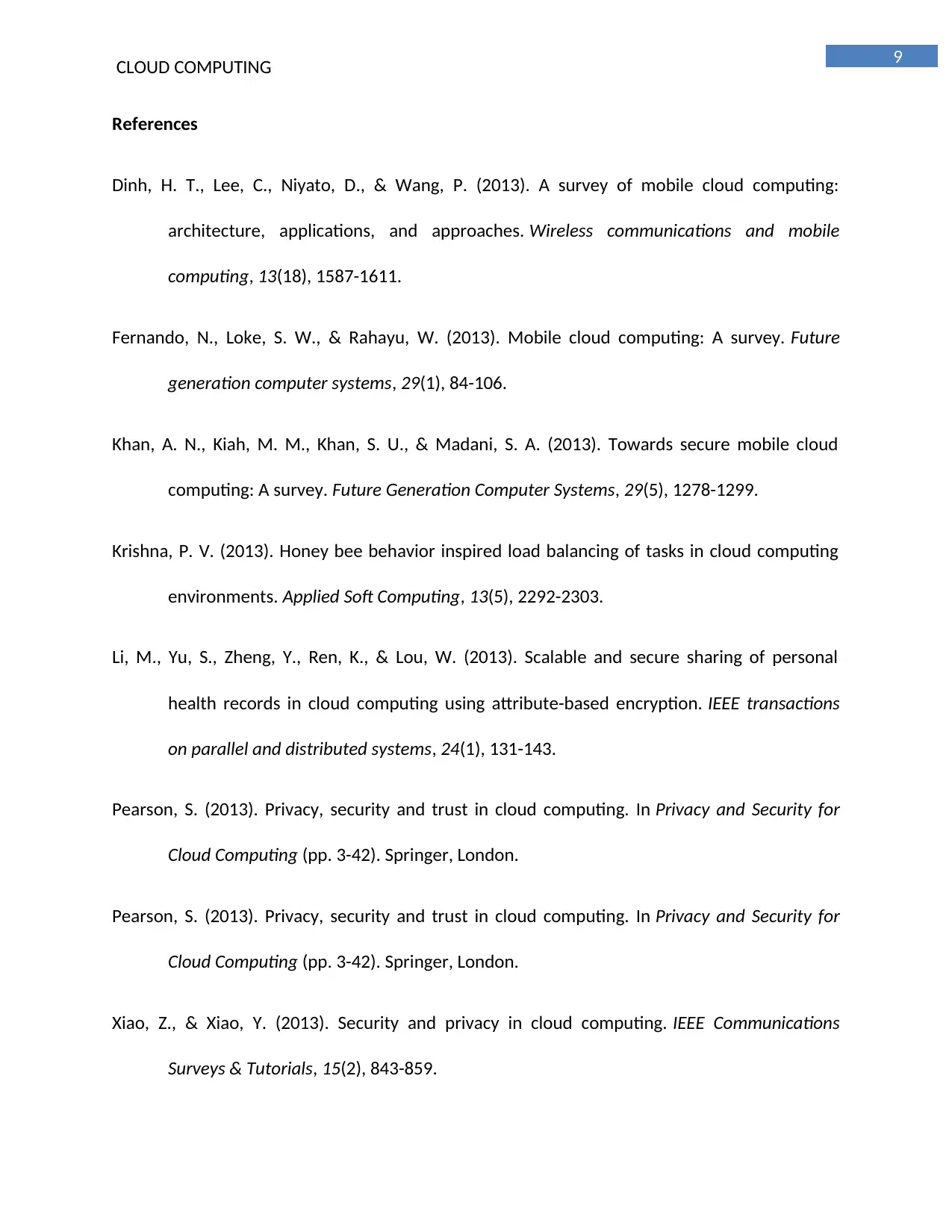
9
CLOUD COMPUTING
References
Dinh, H. T., Lee, C., Niyato, D., & Wang, P. (2013). A survey of mobile cloud computing:
architecture, applications, and approaches. Wireless communications and mobile
computing, 13(18), 1587-1611.
Fernando, N., Loke, S. W., & Rahayu, W. (2013). Mobile cloud computing: A survey. Future
generation computer systems, 29(1), 84-106.
Khan, A. N., Kiah, M. M., Khan, S. U., & Madani, S. A. (2013). Towards secure mobile cloud
computing: A survey. Future Generation Computer Systems, 29(5), 1278-1299.
Krishna, P. V. (2013). Honey bee behavior inspired load balancing of tasks in cloud computing
environments. Applied Soft Computing, 13(5), 2292-2303.
Li, M., Yu, S., Zheng, Y., Ren, K., & Lou, W. (2013). Scalable and secure sharing of personal
health records in cloud computing using attribute-based encryption. IEEE transactions
on parallel and distributed systems, 24(1), 131-143.
Pearson, S. (2013). Privacy, security and trust in cloud computing. In Privacy and Security for
Cloud Computing (pp. 3-42). Springer, London.
Pearson, S. (2013). Privacy, security and trust in cloud computing. In Privacy and Security for
Cloud Computing (pp. 3-42). Springer, London.
Xiao, Z., & Xiao, Y. (2013). Security and privacy in cloud computing. IEEE Communications
Surveys & Tutorials, 15(2), 843-859.
CLOUD COMPUTING
References
Dinh, H. T., Lee, C., Niyato, D., & Wang, P. (2013). A survey of mobile cloud computing:
architecture, applications, and approaches. Wireless communications and mobile
computing, 13(18), 1587-1611.
Fernando, N., Loke, S. W., & Rahayu, W. (2013). Mobile cloud computing: A survey. Future
generation computer systems, 29(1), 84-106.
Khan, A. N., Kiah, M. M., Khan, S. U., & Madani, S. A. (2013). Towards secure mobile cloud
computing: A survey. Future Generation Computer Systems, 29(5), 1278-1299.
Krishna, P. V. (2013). Honey bee behavior inspired load balancing of tasks in cloud computing
environments. Applied Soft Computing, 13(5), 2292-2303.
Li, M., Yu, S., Zheng, Y., Ren, K., & Lou, W. (2013). Scalable and secure sharing of personal
health records in cloud computing using attribute-based encryption. IEEE transactions
on parallel and distributed systems, 24(1), 131-143.
Pearson, S. (2013). Privacy, security and trust in cloud computing. In Privacy and Security for
Cloud Computing (pp. 3-42). Springer, London.
Pearson, S. (2013). Privacy, security and trust in cloud computing. In Privacy and Security for
Cloud Computing (pp. 3-42). Springer, London.
Xiao, Z., & Xiao, Y. (2013). Security and privacy in cloud computing. IEEE Communications
Surveys & Tutorials, 15(2), 843-859.
1 out of 10
Related Documents
Your All-in-One AI-Powered Toolkit for Academic Success.
+13062052269
info@desklib.com
Available 24*7 on WhatsApp / Email
![[object Object]](/_next/static/media/star-bottom.7253800d.svg)
Unlock your academic potential
Copyright © 2020–2025 A2Z Services. All Rights Reserved. Developed and managed by ZUCOL.





